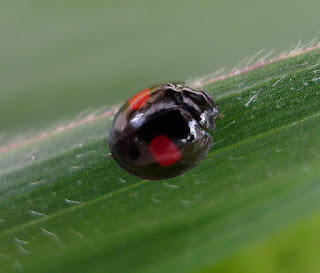Yesterday (probably due to global warming eh) was a beautiful Sunday, with autumnal colours everywhere and blue skies and that lovely low-angled sunshine that makes everything all contrasty and dramatic. So, in combination with enjoying a country walk with my other half, I thought I'd have a look for some ferns in solidarity with the fellow pteridologists among you.
This was successful, so I offer my encouragement if you choose this group.
I live in North Wiltshire, in an area once famous for its limestone quarries. So the roads and fields are lined with walls made of limestone. Some ferns are very happy living on these. Here we have Maidenhair spleenwort,
Asplenium trichomanes. It's only small and it grows in tufts on the wall or (as in this case) from the mortar between the stones of the wall.
 |
| Maidenhair spleenwort |
Very close by was Wall rue,
Asplenium ruta-muraria (below). It doesn't look so obviously 'ferny' as the Maidenhair spleenwort. But if you've found the latter, it's worth looking for this one too. To confirm it's a fern, look at the sori on the back of the leaves:
 |
| Wall rue |
I knew both of those were around locally from fern-forays last year. But on another wall nearby I was delighted to find the Rusty-back fern,
Asplenium ceterach. I've never knowingly found that one, so was genuinely nerdily delighted. It's got a lovely uneven look about it, and on the back the sori have a dense covering of scales. You can see that in the young leaves the scales are rather silvery, and in the older bigger leaves they're rust brown (hence the name).
 |
| Rusty-back fern |
There is a strange 'alleyway' of two low drystone walls that you have to go down to enter the wood where we were headed. It seems to be the ideal microclimate for mosses - I've gathered many different ones there in the past, and picked up a few this time that I'll show you in another post. It also seemed good for another type of fern - a type of Polypodium.
 |
| Western polypody |
I think it's
Polypodium interjectum, Western polypody. That's because (unlike Common polypody), it has pointed tips to its pinnae and (unlike Southern polypody) it doesn't seem to have any hairlike structures growing amidst the sporangia. You can also find hybrids of the three, but I think the lovely bold and plump sori suggest otherwise (the hybrids are usually sterile).
Within the wood itself I came across this plant, which as you can see was far too large to fit on the photocopier. That's one thing you'll have to find a solution for when you're pressing your specimens - you'll need a bit of space, and preferably you don't want to fold them over like this!
 |
| Soft shield fern |
You can see it's got beautiful reddish-brown scales at the base of the stem - it's important that you pick the frond all the way down to these when you're collecting samples.
Here's a close-up of the pinnules and sori:
 |
| Soft shield fern |
If you look closely (you'll find a hand lens useful for your own identifications) you can see that the pinnules of this plant generally have a kind of mitteny, thumbed outline. Their lobes are rather pointed, with little hair points at their tip. Combined with the roundness (as opposed to a kidney-shapedness) of the covers of the sori (or 'indusia') - we know that this is a shield fern.
I've been through this wood botanising before, and I've collected both the Hard shield fern (
Polystichum aculeatum) and the Soft shield fern
(Polystichum setiferum) here. This has turned out to be useful, because I know
P. aculeatum lives up to its name and is really quite stiff, the hair points being rather prickly. But this specimen is not like that at all, and is instead the Soft shield fern,
P. setiferum. I think you'll find yourself in the same position after a while, able to make comparisons when you've found and examined a few species which (when you first look at the key) look confusing and impossible.
I also spotted some fairly miserable specimens of Bracken (
Pteridium aquilinum) on the way to the wood. It's very distinctive with its large size and tripinnate structure.
Another species which is unmistakable is the Hart's tongue fern (
Asplenium scolopendrium). It is everywhere in the wood at the moment, forming big exuberant green clumps of foliage. You'd be tripping over them. The sori are linear (and usually a bit clearer than on my photo).
 |
| Hart's-tongue fern |
So that's seven species just from a morning's work/walk. I know there are Male ferns and Hard shield ferns close by too. So that makes nine. Hard fern is another common species but I'd need to travel elsewhere to find that one - it prefers acidic conditions. Ten species would make a very respectable start. Depending on where you can travel to, you might also be able to find Sea spleenwort (by the sea, unsurprisingly), Black spleenwort, Brittle bladder fern, Lady fern, Lemon scented fern, Broad buckler fern, Narrow buckler fern... plus others.
The 3rd edition of Merryweather's guide is currently at a sale price of £6.50 from the FSC - a bargain.















































